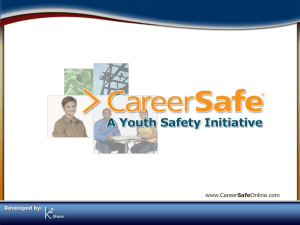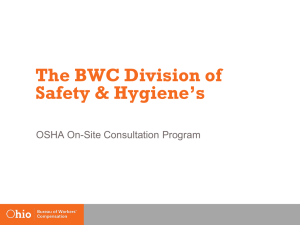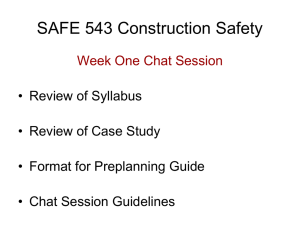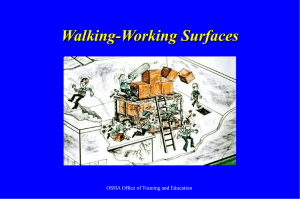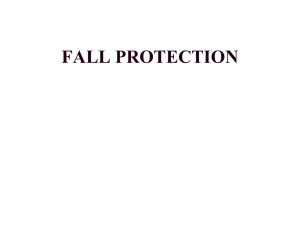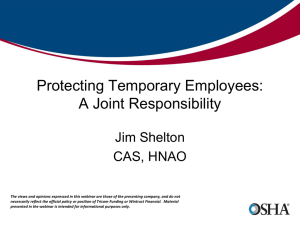files/Safety and OSHA
advertisement
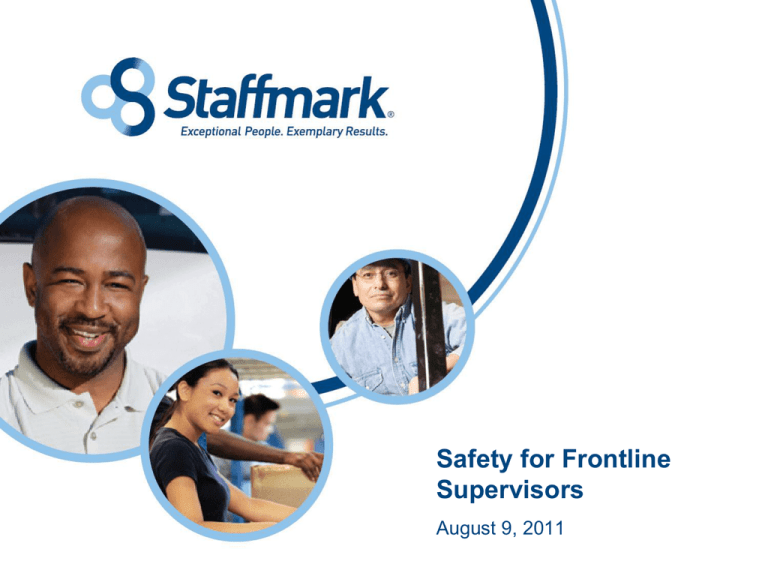
Safety for Frontline Supervisors August 9, 2011 Table of Contents ● ● ● ● ● ● ● ● ● ● ● ● OSHA Required Written and Training Programs Personal Protective Equipment Walking/Working Surfaces Machine Guarding Lockout/Tagout Electrical Hazard Communication Emergency Egress Powered Industrial Trucks Industrial Hygiene Ergonomics OSHA ● Occupational Safety and Health Act of 1970. ● “To assure so far as possible every working man and woman in the nation safe and healthful working conditions…” ● Everyone must comply with OSHA Standards. ● OSHA can be enforced by either the Federal or State Government depending on the state – Arkansas is a Federal State for OSHA. ● The Federal OSHA website is www.osha.gov. ● OSHA Inspection Priorities are as follows: o o o o Imminent danger Catastrophes and fatal accidents Employee complaints High hazard industries 3 Reason for OSHA ● Annual Statistics: o About 6,000 deaths from workplace injuries o An estimated 50,000 deaths from illnesses cause by workplace exposures o 6 million non-fatal workplace injuries o Injuries alone cost U.S. businesses more than $125 billion 4 Impact of OSHA Since 1970 ● Cut the work-related fatality rate in half ● Reduced overall injury and illness rates in industries where OSHA concentrated its attention ● Virtually eliminated brown lung disease in the textile industry, and ● Reduced trenching and excavation fatalities by 35 percent 5 Functions of OSHA ● Encourages employers and employees to reduce workplace hazards and implement new or improve existing safety and health programs ● Develops and enforces mandatory job safety and health standards ● Maintains a reporting and recordkeeping system to monitor jobrelated injuries and illnesses ● Provides assistance, training and other support programs to help employers and workers 6 OSHA Standards ● OSHA is responsible for writing and enforcing standards that employers must follow ● Where OSHA has not issued specific standards, employers are responsible for following the OSH Act's “General Duty Clause” ● States with OSHA-approved programs must set standards at least as effective as federal standards 7 OSHA Workers’ Page 8 OSHA Inspection Process ● ● ● ● CSHO displays official credentials Opening conference Walk around inspection Closing conference 9 OSHA Emergency Hot-Line 1-800-321-OSHA ● Hot-line for reporting workplace safety or health emergencies ● Provides a 24-hour point of contact to report imminent dangers on the job 10 Sources of Assistance for Small Businesses ● OSHA Office of Small Business Assistance o http://www.osha.gov/dcsp/osba/index.html ● OSHA Compliance Assistance Quick Start o http://www.osha.gov/dcsp/compliance_assistance/quickstarts/gener al_industry/index_gi.html ● OSHA Small Business Handbook o http://www.osha.gov/Publications/smallbusiness/small-business.html ● Safety & Health Achievement Recognition Program (SHARP) o Arkansas Department of Labor OSHA Consultation Division • http://www.arkansas.gov/labor/divisions/osha_p1.html ● Workers’ Compensation Carrier 11 Required Written and Training Programs ● ● ● ● ● ● ● All Workplaces General Safety Hazard Abatement Hazard Communication Emergency Action Plans Fire Protection Recordkeeping ● ● ● ● ● ● ● ● ● ● ● Hospital/Clinical Bloodborne Pathogens Industrial Environments Powered Industrial Trucks Cranes Hot Works Lockout/Tagout Electrical Confined Space Bloodborne Pathogens Personal Protective Equipment 12 Personal Protective Equipment (PPE) ● PPE is the last line of defense ● Engineering controls are preferable: o o o o o o Initial design specifications Substitute less harmful material Change process Enclose process Isolate process Ventilation ● Work practice controls are also preferable: o o o o Use of wet methods to suppress dust Personal hygiene Housekeeping and maintenance Job rotation of workers 13 Personal Protective Equipment (PPE) ● Establish a PPE Program by: o Sets out procedures for selecting, providing and using PPE as part of an employer’s routine operation o Assess the workplace to determine if hazards are present o Once the proper PPE has been selected, the employer must provide training ● Training must include: o o o o o When PPE is necessary What type of PPE is necessary How to properly put on, take off, adjust, and wear Limitations of the PPE Proper care, maintenance, useful life and disposal 14 Walking/Working Surfaces ● Housekeeping o Workroom floors must be maintained as clean and dry as possible o Workplaces must be kept clean, orderly, and sanitary ● Aisles o Keep clear and move obstructions that could create a hazard o Mark permanent aisles and passageways o Aisles must be sufficiently wide where mechanical handling equipment is used 15 Walking/Working Surfaces ● Open-sided floors or platforms 4 feet or more above adjacent floor or ground level must be guarded by a standard railing on all open sides ● A toeboard is required when, beneath the open sides: o persons can pass, o there is moving machinery, or o there is equipment with which falling materials could create a hazard ● Standard railing. Consists of top rail, mid rail, and posts. Height from the upper surface of top rail to floor level is 42 inches. Mid rail height is 21 inches. ● Standard toeboard. 4 inches high, with not more than ¼-inch clearance above the floor. 16 Machine Guarding ● Any machine part, function, or process which may cause injury must be safeguarded ● Point of operation ● All parts of the machine which move, such as: o flywheels, pulleys, belts, couplings, chains, cranks, gears, etc. o feed mechanisms and auxiliary parts of the machine ● In-running nip points ● Point-of-Operation is defined as where the work is performed on the material, such as cutting, shaping, boring, or forming of stock 17 Machine Guarding ● Requirements for Machine Guards: o Prevent contact - prevent worker’s body or clothing from contacting hazardous moving parts o Secure - firmly secured to machine and not easily removed o Protect from falling objects - ensure that no objects can fall into moving parts o Create no new hazards - must not have shear points, jagged edges or unfinished surfaces o Create no interference - must not prevent worker from performing the job quickly and comfortably o Allow safe lubrication - if possible, be able to lubricate the machine without removing the safeguards 18 Types of Machine Guards ● Guards o o o o ● fixed interlocked adjustable self-adjusting Devices o o o o o presence sensing pullback restraint safety controls (tripwire cable, two-hand control, etc.) gates ● ● Location/distance Feeding and ejection methods o o ● Miscellaneous aids o ● automatic and/or semiautomatic feed and ejection robots awareness barriers protective shields o hand-feeding tools 19 Machine Guarding ● Holding Tools ● Used to place and remove stock in the danger area ● Not to be used instead of other machine safeguards, but as a supplement 20 Lockout/Tagout ● Lockout/Tagout is a technique used to prevent the release of hazardous energy, or to prevent the hazardous energy from escaping while machinery or equipment is being maintained ● Five main causes of injuries with Lockout/Tagout o o o o o Failure to stop equipment Failure to disconnect from power source Failure to dissipate (bleed, neutralize) residual energy Accidental restarting of equipment Failure to clear work areas before restarting 21 Lockout/Tagout ● Sources of Energy to Control o Electrical • • o Mechanical • • o Transitional Rotational Thermal • • o Generated Static Machines or Equipment Chemical Reactions ● Energy Control Devices o o o o o o Plug Locks Ball Valve Lockout Gate Valve Lockout Group Lockout Hasp Electrical Hydraulic, pneumatic, and other pressurized systems Potential • Pressure – – – • • Hydraulic Pneumatic Vacuum Springs Gravity 22 Electrical ● There are four main types of electrical injuries: o o o o Electrocution (death due to electrical shock) Electrical shock Burns Falls ● Severity of the shock depends on: o Path of current through the body o Amount of current flowing through the body o Length of time the body is in the circuit 23 Electrical Hazards ● Hazards o o o o o o o o Inadequate wiring Exposed electrical parts Wires with bad insulation Ungrounded electrical systems and tools Overloaded circuits Damaged power tools and equipment Using the wrong PPE and tools Overhead powerlines ● All hazards are made worse in wet conditions 24 Countermeasures to Electrical Hazards ● ● ● ● ● ● Proper grounding Using GFCIs Using fuses and circuit breakers Guarding live parts Proper use of flexible cords Training 25 Hazard Communication ● Written Program Requirements o Describes container labeling, MSDSs, and employee training for each workplace o List of the hazardous chemicals o Make information regarding hazards and protective measures available to other employers onsite ● Chemical Labels Must Include o Identity of the chemical o Appropriate hazard warnings o Name and address of the responsible party 26 Emergency Egress ● A continuous and unobstructed way of exit travel from any point in a building or structure to a public way (a street, yard, court or other open space leading to the street) ● Three parts to an escape route: o the way of exit access; o the exit; and o the way of exit discharge. 27 Powered Industrial Trucks ● ● ● ● ● ● ● ● ● ● Written certification program Classroom training Hands-on training Written evaluation Operations evaluation Inspection of equipment Refueling/recharging Proper storage Ventilation PPE 28 Industrial Hygiene ● Ventilation o Direct o General ● Air sampling o o o o Dusts Fumes Vapors Gases 29 Ergonomics ● Workstation Design o ● ● ● ● ● Neutral position Lighting Adjustable heights Seats versus standing Anti-fatigue mats Tools/Equipment ● ● ● ● ● In-line tools Padding Pallet lift tables Job rotation Stretching exercises 30 Questions The information contained herein is confidential information to and is the exclusive property of Staffmark, its parent company, CBS Personnel Holdings, Inc., (and its subsidiaries: Staffmark Investment LLC, CBS Personnel Services, LLC, CBS Personnel Services, LLC dba “Venturi Staffing,” and Kilgore Group, Inc.) and is only to be used by Recipient in evaluating the services of such entities. Neither the documents nor the contents of the documents are to be used, reproduced or disclosed, in whole or in part, by Recipient without the expressed written permission of Staffmark or CBS Personnel Holdings, Inc. The information should be destroyed or returned to Discloser when no longer needed.



